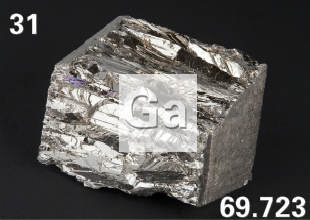Chemical properties of Gallium
- Atomic number:
- 31
- Atomic mass:
- 69.723g.mol -1
- Electronegativity according to:
- 1.81
- Density:
- 5.91 g.cm -3
- Melting point:
- 29.76 °C
- Boiling point:
- 85.57 °C
- Vanderwaals radius:
- 0.187 nm
- Ionic radius:
- 0.135
- Electronic shell:
- [ Ar ] 3d10 4s2 4p1
- Energy of first ionisation:
- 578.8 kJ.mol -1
Gallium is a chemical element with symbol Ga and atomic number 31. Elemental gallium does not occur in free form in nature, but as the gallium(III) compounds that are in trace amounts in zinc ores and in bauxite. Gallium is a soft, silvery metal, and elemental gallium is a brittle solid at low temperatures, and melts at 29.76 °C (85.57 °F) (slightly above room temperature). The melting point of gallium is used as a temperature reference point. The alloy galinstan (68.5% gallium, 21.5% indium, and 10% tin) has an even lower melting point of −19 °C (−2 °F), well below the freezing point of water. Since its discovery in 1875, gallium has been used as an agent to make alloys that melt at low temperatures. It has also been useful in semiconductors, including as a dopant.
Applications
Because of this application, extremely high-purity (99.9999+%) gallium is commercially available. Gallium arsenide (GaAs) and gallium nitride(GaN) used in electronic components represented about 98% of the gallium consumption in the United States in 2007. Gallium arsenide is used in optoelectronics in a variety of infrared applications. Gallium readily alloys with most metals, and has been used as a component in low-melting alloys.
Gallium in the environment
Gallium is a byproduct of the production of aluminium and zinc, whereas the sphalerite for zinc production is the minor source. Most gallium is extracted from the crude aluminium hydroxide solution of the Bayer process for producing alumina and aluminium. A mercury cell electrolysisand hydrolysis of the amalgam with sodium hydroxide leads to sodium gallate. Electrolysis then gives gallium metal. For semiconductor use, further purification is carried out using zone melting, or else single crystal extraction from a melt (Czochralski process). Purities of 99.9999% are routinely achieved and commercially widely available.
Applications
Because of this application, extremely high-purity (99.9999+%) gallium is commercially available. Gallium arsenide (GaAs) and gallium nitride(GaN) used in electronic components represented about 98% of the gallium consumption in the United States in 2007. Gallium arsenide is used in optoelectronics in a variety of infrared applications. Gallium readily alloys with most metals, and has been used as a component in low-melting alloys.
Gallium in the environment
Gallium is a byproduct of the production of aluminium and zinc, whereas the sphalerite for zinc production is the minor source. Most gallium is extracted from the crude aluminium hydroxide solution of the Bayer process for producing alumina and aluminium. A mercury cell electrolysisand hydrolysis of the amalgam with sodium hydroxide leads to sodium gallate. Electrolysis then gives gallium metal. For semiconductor use, further purification is carried out using zone melting, or else single crystal extraction from a melt (Czochralski process). Purities of 99.9999% are routinely achieved and commercially widely available.


